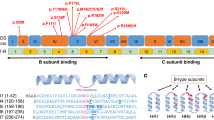Abstract
CAPZA2 encodes the α2 subunit of CAPZA, which is vital for actin polymerization and depolymerization in humans. However, understanding of diseases associated with CAPZA2 remains limited. To date, only three cases have been documented with neurodevelopmental abnormalities such as delayed motor development, speech delay, intellectual disability, hypotonia, and a history of seizures. In this study, we document a patient who exhibited seizures, mild intellectual disability, and impaired motor development yet did not demonstrate speech delay or hypotonia. The patient also suffered from recurrent instances of respiratory infections, gastrointestinal and allergic diseases. A novel de novo splicing variant c.219+1 G > A was detected in the CAPZA2 gene through whole-exome sequencing. This variant led to exon 4 skipping in mRNA splicing, confirmed by RT-PCR and Sanger sequencing. To our knowledge, this is the third study on human CAPZA2 defects, documenting the fourth unambiguously diagnosed case. Furthermore, this splicing mutation type is reported here for the first time. Our research offers additional support for the existence of a CAPZA2-related non-syndromic neurodevelopmental disorder. Our findings augment our understanding of the phenotypic range associated with CAPZA2 deficiency and enrich the knowledge of the mutational spectrum of the CAPZA2 gene.
This is a preview of subscription content, access via your institution
Access options
Subscribe to this journal
Receive 12 print issues and online access
$259.00 per year
only $21.58 per issue
Buy this article
- Purchase on Springer Link
- Instant access to full article PDF
Prices may be subject to local taxes which are calculated during checkout


Similar content being viewed by others
References
Bastos F, Cross JH. Epilepsy. Handb Clin Neurol. 2020;174:137–58.
Guerrini R. Epilepsy in children. Lancet. 2006;367:499–524.
Fine A, Wirrell EC. Seizures in Children. Pediatr Rev. 2020;41:321–47.
Carney P, Prowse MA, Scheffer IE. Epilepsy syndromes in children. Aust Fam Physician. 2005;34:1009–15.
Sharma P, Hussain A, Greenwood R. Precision in pediatric epilepsy. F1000Res. 2019;8:F1000.
Striano P, Minassian BA. From genetic testing to precision medicine in epilepsy. Neurotherapeutics. 2020;17:609–15.
Huang Y, et al. Variants in CAPZA2, a member of an F-actin capping complex, cause intellectual disability and developmental delay. Hum Mol Genet. 2020;29:1537–46.
Pi S, et al. A de novo inframe deletion variant in CAPZA2 tentacle domain with global developmental delay and secondary microcephaly. Clin Genet. 2022;102:355–6.
Richards S, et al. Standards and guidelines for the interpretation of sequence variants: a joint consensus recommendation of the American College of Medical Genetics and Genomics and the Association for Molecular Pathology. Genet Med. 2015;17:405–24.
Narita A, et al. Structural basis of actin filament capping at the barbed-end: a cryo-electron microscopy study. EMBO J. 2006;25:5626–33.
Zigmond SH. Beginning and ending an actin filament: control at the barbed end. Curr Top Dev Biol. 2004;63:145–88.
Pollard TD, Borisy GG. Cellular motility driven by assembly and disassembly of actin filaments. Cell. 2003;112:453–65.
Weeds A, Maciver S. F-actin capping proteins. Curr Opin Cell Biol. 1993;5:63–9.
Wear MA, et al. How capping protein binds the barbed end of the actin filament. Curr Biol. 2003;13:1531–7.
Yamashita A, Maeda K, Maeda Y. Crystal structure of CapZ: structural basis for actin filament barbed end capping. EMBO J. 2003;22:1529–38.
Hopmann R, Cooper JA, Miller KG. Actin organization, bristle morphology, and viability are affected by actin capping protein mutations in Drosophila. J Cell Biol. 1996;133:1293–305.
McEntagart M, et al. A restricted repertoire of de novo mutations in ITPR1 cause gillespie syndrome with evidence for dominant-negative effect. Am J Hum Genet. 2016;98:981–92.
Herskowitz I. Functional inactivation of genes by dominant negative mutations. Nature. 1987;329:219–22.
Gerasimavicius L, Livesey BJ, Marsh JA. Loss-of-function, gain-of-function and dominant-negative mutations have profoundly different effects on protein structure. Nat Commun. 2022;13:3895.
Veitia RA, Caburet S, Birchler JA. Mechanisms of Mendelian dominance. Clin Genet. 2018;93:419–28.
Backwell L, Marsh JA. Diverse molecular mechanisms underlying pathogenic protein mutations: beyond the loss-of-function paradigm. Annu Rev Genomics Hum Genet. 2022;23:475–98.
Amberger JS, et al. OMIM.org: leveraging knowledge across phenotype-gene relationships. Nucleic Acids Res. 2019;47:D1038–D1043.
Rehm HL, et al. ClinGen—the clinical genome resource. N. Engl J Med. 2015;372:2235–42.
Hart MC, Korshunova YO, Cooper JA. Vertebrates have conserved capping protein alpha isoforms with specific expression patterns. Cell Motil Cytoskeleton. 1997;38:120–32.
Jiang S, et al. Overexpression of CAPG is associated with poor prognosis and immunosuppressive cell infiltration in ovarian cancer. Dis Markers. 2022;2022:9719671.
Acknowledgements
The authors are grateful to the patient and his family for their participation in this study. This research project was supported by the Henan Children’s Hospital. The authors would also like to express their gratitude to all individuals who assisted throughout this project.
Funding
National Natural Science Foundation of China (81701125); National Population Health Data Center Project (sub-project: SJPT-03-01) Henan Medical Education Research Project (Wjlx2022148).
Author information
Authors and Affiliations
Contributions
Kai-Li Xu, Li Wang, Dai-Qi Mei, and Liu-Jiong Gao provided clinical data. Xiao-Man Zhang, Jing-Hui Kong, Geng Dong, Shi-Jie Dong, Zhi-Xiao Yang, Shu-Jing Xu and Wei-Yue Gu analyzed data. Xiao-Man Zhang, Shu-Ying Luo, Yao-Dong Zhang, and Shi-Yue Mei drafted and edited the manuscript. All authors contributed to editing.
Corresponding author
Ethics declarations
Competing interests
The authors declare no competing interests.
Additional information
Publisher’s note Springer Nature remains neutral with regard to jurisdictional claims in published maps and institutional affiliations.
Rights and permissions
Springer Nature or its licensor (e.g. a society or other partner) holds exclusive rights to this article under a publishing agreement with the author(s) or other rightsholder(s); author self-archiving of the accepted manuscript version of this article is solely governed by the terms of such publishing agreement and applicable law.
About this article
Cite this article
Zhang, XM., Xu, KL., Kong, JH. et al. Heterozygous CAPZA2 mutations cause global developmental delay, hypotonia with epilepsy: a case report and the literature review. J Hum Genet 69, 197–203 (2024). https://doi.org/10.1038/s10038-024-01230-z
Received:
Revised:
Accepted:
Published:
Issue Date:
DOI: https://doi.org/10.1038/s10038-024-01230-z



